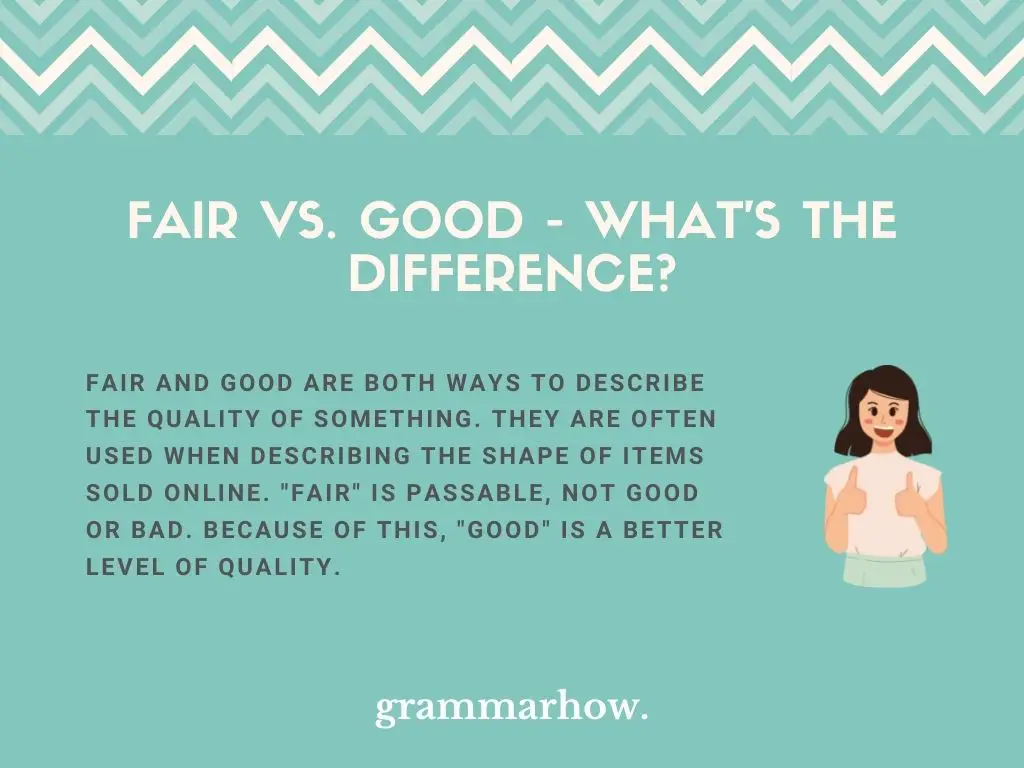Do you worry about making silly mistakes when speaking or writing? Does the difference between “fair” and “good” give you pause? After all, no one likes to make mistakes.
In this post, we will discuss the differences between fair and good, as well as when to use them.
Fair vs. Good – What’s the Difference?
Fair and good are both ways to describe the quality of something. They are often used when describing the shape of items sold online. “Fair” is passable, not good or bad. Because of this, “good” is a better level of quality.

There are many examples of this rating system in the world. For instance, there is “fair” and “good” credit, or “fair” and “good” condition. “Fair” is the level beneath “good” in many of these setups. So, “fair” is considered worse than good, but better than bad.
In some cases, “fair” and “good” are used synonymously. Some people consider the two words to have the same meaning. However, this is rare. “Good” will be better than “fair” in the majority of cases.
You can apply this logic to other aspects of life as well. You can have a “fair” day instead of a “good” day. Such a day is not quite good, but not bad either. This is just one example.
Fair
Merriam-Webster’s definition of fair is, “not very good or very bad: of average or acceptable quality”. Some things are not truly good, but not truly bad either. “Fair” is how you’d describe those things. It could be better, but it could be worse too.
This is important when you are shopping online. A product may be listed as fair. This means its condition is not that good. It’s just passable.
Consider the following examples:
- This old TV has a broken button and some scratches, so I’d say that it’s in fair condition.
- My house is in fair condition, but it needs some new paint and some rewiring done.
These examples describe things that are not in terrible shape, but they aren’t in particularly good shape either. That’s the meaning of “fair condition”.
The next level up in condition is “good”, and the level below is “bad”. This gives you an accurate idea of the quality in question.
Good
Merriam-Webster’s definition of “good” is “of a favorable character or tendency”. Something in favorable condition is “good”. This is a step up from something that is just in passable condition.
“Passable” means you are willing to accept something. “Good” means you actively want it, because it is desirable. This is why “good” is better than fair”.
Consider the following examples:
- I’ve done maintenance on this car every month, so it’s in good condition.
- This shirt I’ve bought is brand new, so of course it is in good condition.
These examples describe things that are in a favorable state. They have qualities or features that are desirable. They are something you would want or consider beneficial. A brand-new shirt is not damaged, faded, or stained. That is “good” condition.
If the shirt was a little faded or had a single hole in it, you could call it “fair”. If there was a huge rip right down the middle that made it unwearable, that would obviously be “bad”.
Conclusion
“Fair” and “good” both describe the quality of something. “Fair” is not bad, but it is not good either. It falls between the two ratings. “Good” is a higher quality than “fair”, just like “great” is a higher quality than “good”.
There is no situation where “fair” is better than “good”. Keep this in mind while shopping online.

Martin holds a Master’s degree in Finance and International Business. He has six years of experience in professional communication with clients, executives, and colleagues. Furthermore, he has teaching experience from Aarhus University. Martin has been featured as an expert in communication and teaching on Forbes and Shopify. Read more about Martin here.
